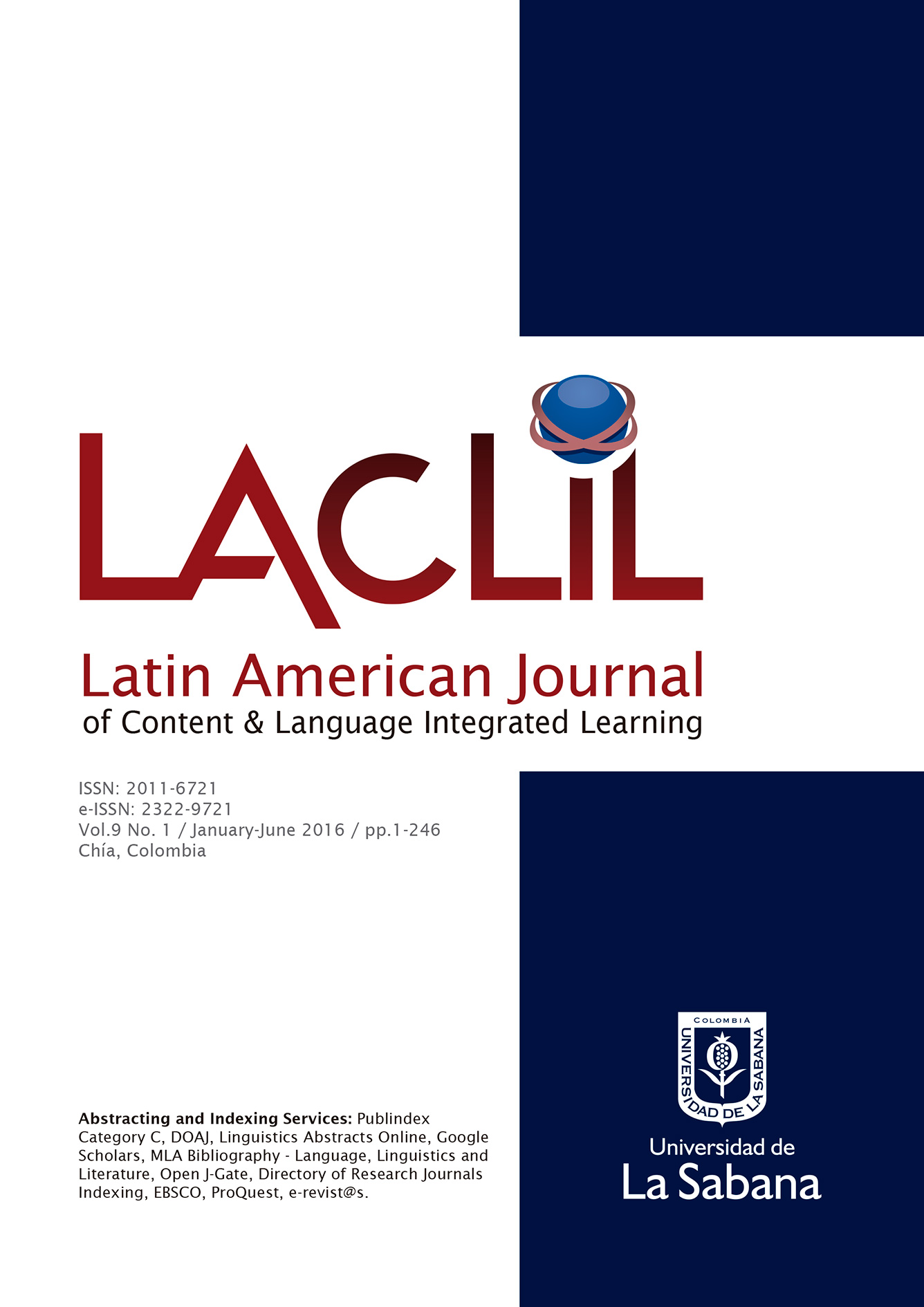Los efectos de la educación AICLE en la materia en cuestión (matemáticas) y la lengua objetivo (inglés)
DOI:
https://doi.org/10.5294/5493Palabras clave:
CLIL, el multilingüismo, la cognición, matemáticas, inglésResumen
Este artículo investiga los efectos de aprendizaje integrado de contenido y lenguas extranjeras (AICLE), tanto en la consecución de la materia, las matemáticas en nuestro caso, como también en el aspecto del contenido de AICLE. El segundo eje de investigación se centra en el efecto de AICLE en la competencia de los alumnos cara a cara a la lengua de instrucción, personificada aquí por el inglés, el cual hace parte del aspecto lingüístico de la enseñanza CLIL. En este trabajo se adopta una metodología de enfoque múltiple para hacer frente a las preguntas de investigación que nos ocupan. Se concluye —sobre la base del trabajo de campo, esto incluye la codificación de datos y su análisis; el diseño y el análisis del cuestionario; una prueba matemática administrada, y la evaluación continua de los maestros a sus estudiantes— que la educación AICLE es más eficaz que los sistemas tradicionales de educación para ayudar a los estudiantes a lograr altos niveles de competencia en el idioma objetivo (inglés) y para alcanzar altos niveles de competencia en la materia (matemáticas). Estos resultados podrían explicarse por la existencia de un intercambio oculto entre los mecanismos del cerebro implicados en el aprendizaje de las matemáticas y los idiomas, así como por las oportunidades pedagógicas, proporcionadas por el entorno AICLE, y que hacen eco, en gran medida, en el ambiente de adquisición de L1.Descargas
Citas
Bibliography
Baker, C. & S. Prys Jones. (1998) Encyclopedia of Bilingulaism and Bilingual Education. Clevedon, Avon: Multilingual Matters.
Bamford, K. & Mizokawa, D. (1991) Additive-bilingual (immersion) education: Cognitive and language development. Language Learning 41(3), 413-429.
Bialystok, E. (2005) The Impact of Bilingualism on Language and Literacy Development. In (eds.) Bhatia, T. K & Titchie, W. C., Handbook of Bilingualism (2006) Oxford: Blackwell, 577-602.
Bialystok, E., F. Craik & M. Freedman. (2006) Blingualism as a protection against the onset of symptoms of dementia. Neuropsychologia 45, 459-464.
Burbaud, P. Degreze, P., Lafon, P., Franconi, J. M., Bouligand, B., Bioulac, et al.
(1995). Lateralization of prefrontal activation during internal mental calculation: A functional magnetic resonance imaging study. Journal of Neuropsychology, 74, 2194-2200.
Byrnes, J. P. (2001). Minds, Brains, and Learning: Understanding the psychological and
educational relevance of neuroscientific research. New York: Guilford Press.
Ceuleers, E. (in print) ‘Variable Identities in Brussels. Language learning, motivation and identity of adolescents in a Dutch-speaking school in Brussels”. Journal of Multilingual and Multicultural Development.
Cowell, S. F., Egan, G. F., Code, C., Harasty, J., & Watson, J. D. (2000). The functional
neuroanatomy of simple calculation and number repetition: A parametric PET activation study. Neuroimage, 12 565-573.
Dehaene, S., Spelke, E., Pinel, P., Stanescu, R., & Tsivkin, S. (1999). Sources of
Mathematical thinking: Behavioral and brain-imaging evidence. Science, 284, 970-974.
Du Bois. W. J, S. Schuetze-Coburn, S. Cumming,& D. Paolino (1993). Outline of discourse transcription. In J. Edwards & M. D. Lampert (eds) Talking Data: Transcription and Coding in Discourse Research. Hillsdale: Lawrence Erlbaum Association.
Edwards, J. A. (2007) The Transcription of Discourse: The Handbook of Discourse Analysis. Blackwell Reference Online.
Hiebert, J., & LeFever, P. (1987). Conceptual and procedural knowledge in mathematics: An introductory analysis. In J. Hiebert (ed.), Conceptual and procedural knowledge in mathematics (pp. 1-27). Hillsdale, NJ: Erlbaum.
Jappinen, A. K. (2005) Thinking and content learning of mathematics and science as cognitional development in content and language integrated learning (CLIL): Teaching through a foreign language in Finland. Language and Education. Vol. 19/2.
Lorenzo, F. S. Casal, & P. Moore (2009) The effects of content and language integrated learning in European education: Key findings from the Andalusian bilingual sections evaluation project. Applied linguistics. Oxford University Press: 1- 25.
Marsh, D. & D. Wolff (eds) (2007). Diverse Contexts- Converging Goals. CLIL in Europe. Frankfurt am Main: Peter Lang, 185-200.
Murray, D. R. (2010) Irish-medium language immersion programs’ effect on mathematics education. Journal of Mathematics Education at Teachers College, Fall-Winter Vol 1.
Van de Craen, P, E. Ceuleers & K. Mondt. (2007a). ‘Cognitive development and bilingualism in primary schools: teaching maths in a CLIL environment’. In: D. . Marsh & D. Wolff (eds) Diverse Contexts- Converging Goals. CLIL in Europe. . Frankfurt am Main: Peter Lang, 185-200.
Van de Crean, P., K. Mondt, L. Allain & Y. Gao. (2007) Why and How CLIL Works. An Outline for a CLIL Theory. Vienna English Working Papers 16(3), 70-78.
Van de Craen, P., K. Lochtman, E. Ceuleers, K. Mondt & L. Allain. (2007b). CLIL An
Interdisciplinary research approach to CLIL learning in primary schools in
Brussels. In: C. Dalton-Puffer & U. Smit (eds) Empirical Perspective on CLIL
Classroom Discourse. Frankfurt am Main: Peter Lang, 253-274.
Van de Cren, P., E. Ceuleers, K. Mondt & L. Allain. (2008). European multilingual
languages policies in Belgium and policy-driven research. In K. Lauridsen & D. Toudic (eds) Languages at Work Festschrift in Honour of Wolfgang Mackiewicz. Gottingen: V
Yen-Ling Teresa Ting (2010) CLIL Appeals to How the Brain Likes Its Information: Examples From CLIL-(Neuro)Science International CLIL Research Journal Vol (1) 3
Electronic references
http://www.sh-dilsen.be/joomla/
http://www.cs.columbia.edu/~sbenus/Teaching/APTD/Edwards_transcription_Handbook_of_DA.pdf
http://oxforddictionaries.com/definition/english/ethnography?q=ethnography
Descargas
Publicado
Cómo citar
Número
Sección
Licencia
Los autores que publican en esta revista están de acuerdo con los siguientes términos:
Esta revista y sus artículos se publican bajo la licencia Creative Commons Atribución-NoComercial-SinDerivadas 4.0 Internacional (CC BY-NC-ND 4.0), por lo cual el usuario es libre de: compartir, copiar y redistribuir el material en cualquier medio o formato, siempre y cuando: dé crédito de manera adecuada, brinde un enlace a la licencia e indique si se han realizado cambios; no use nuestro contenido con propósitos comerciales; y/o remezcle o transforme el material. Recuerde que no tiene los permisos para distribuir el material si fue modificado.








